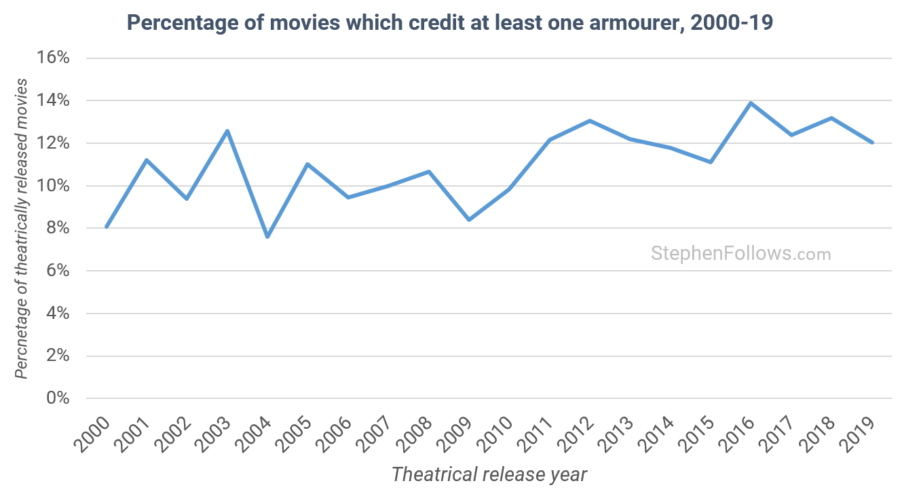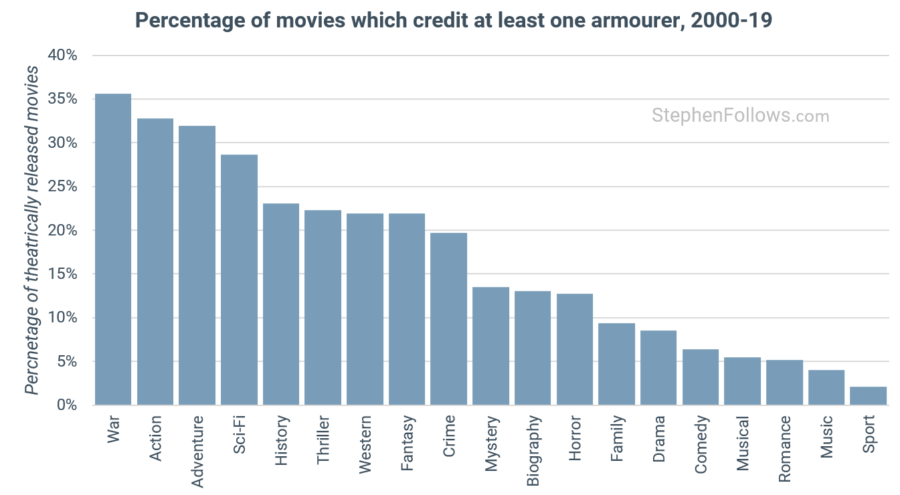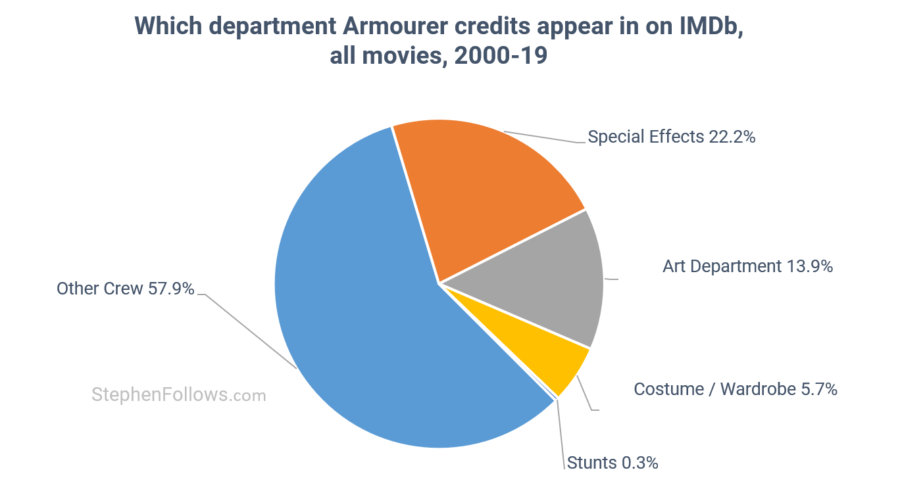You will no doubt have heard of the tragic incident on the set of ‘Rust’ last week.
Right now it seems that Alec Baldwin fired a weapon he incorrectly believed to be blank firing, unintentionally shooting and killing the Director of Photography and wounding the director.
So many people have had important, meaningful and through-provoking things to say on the topic that I don’t think my personal voice is needed on the topic.
However, I have been approached by over thirty readers, asking a myriad of questions about guns on film sets.
I can’t answer all the questions asked (more details on this at the end of the article), but I can address a few.
To do this, I looked at all live-action movies released in US cinemas between 2000 and 2019 and studied their online credits.
What percentage of films employ an armourer?
Let’s start by defining terms.
Much of the news coverage of the event has implied that the role of ‘Armourer’ on a film set relates exclusively and entirely to the use of firearms, ignoring that that could be many types of weapons they oversee, beyond just handguns. In today’s research, I found that the film with the greatest number of such credits was Lord Of The Rings: Return of the The King without a single gun in sight.
Another fallacy is that people who handle weapons will be credited as ‘Armourer’, overlooking other credits such as ‘Weapons Handler’ or ‘Weapons Master’. I have incorporated all these variations in today’s research but for the sake of brevity, I shall refer to all such credits as ‘Armourer’. More on this in the Notes at the end of the article.
Using online credits, we can see that an average of 12% of movies made in the past two decades credited at least one armourer.

Which genres most frequently credit armourers?
The genres most likely to armourers are the ones related to physical action, namely war, action and adventure film. At the other end of the spectrum, we see movies based around sports and music, as well as romantic films.

How are armourers credited?
IMDb lists over half of all such credits in the “Other crew” section. Interestingly, very few credits appear under the Stunt department, which I where I had expected to find them.

I would be interested to hear from informed crew members as to whether an armourer credit in one department or another reveals a lot about the work that person performed, or if it’s just a subjective judgment made by whomever uploads the credit to IMDb.
Notes
The data for today’s research came from a variety of sources, including IMDb, Wikipedia and Metacritic. This research is focused on fiction feature films (so not short films, TV movies, documentaries, etc) and includes all movies released in cinemas in North America between 2000 and 2019. I left out 2020 due to the pandemic making “theatrically released” slightly redundant criteria. I don’t see any reason for the 2020 crop to be significantly different from what we’ve seen above.
It’s worth noting that we can only address credits that have been added to sites like IMDb and Wikipedia. I have previously studied the completeness of movie credits, so I won’t go into it in great detail here other than to note that we will not be getting the full picture. Highly experienced crew may see little need for adding every single credit they earn, and although producers do submit “complete” credit lists, they are often missing some credits.
I included all jobs which are directly related to handling weapons on set, this includes armourers, weapons wranglers, weapons stand-by and more. I excluded any weapons jobs which seemed to be focused on the creation of props (such as fabricators or mould makers) and jobs that were unlikely to be directly related to the handling of the weapons (such as historical weapon advisors).
Epilogue
Many of the questions I could not answer were extremely interesting and valid. These included asking what percentage of muzzle flashes were from physical blank-firing guns versus CGI, counting the number of guns in movies and looking at the types of characters who wield guns in movies.
Apologies if I couldn’t answer your question today but please do keep sending them in as many of the very best ideas on this blog come from readers.





Comments
On a couple of my productions in the US – Chicago and Atlanta locations – we had occasion to fire guns. In each case the weapons were real, not replicas, and were provided by the prop department. In each case there was an armourer and it was made clear to me, as producer, that the ultimate responsibility for checking the guns and notifying the crew lay with the First Assistant. On each occasion the 1st AD called out loud “Guns go hot” twice. The 1st AD had specifically informed me and the director there would be a loud bang but the guns were firing blanks. It never occurred to me that there was any circumstance in which live rounds would be used. If anyone is at fault on ‘Rust’ it must therefore be the First Assistant but apparently the rules may change from state to state. In New Mexico perhaps “Cool Gun” means the same, confusingly, as “Guns go hot” in Illinois and Georgia.
Having read what we know so far about the ‘Rust’ incident, I am amazed because anyone handling a gun must have proper weapons training and every report from that set implies that every rule in dealing with firearms was broken by everybody on set who handled a gun.
The very basic rules are –
1. You check the weapon and the rounds every time when you are handed a gun.
2. Guns are not left unattended but locked in a gun safe.
3. When not in use, all weapons are unloaded.
4. Live rounds can only be used in a controlled environment.
5. Never point a gun, loaded or unloaded, at a person.
6. When loading or unloading or checking a weapon, the gun must be pointing at the ground or at a safety zone (e.g. sandbag enclosure).
The fact that the three people involved, the armourer, the star and the first assistant director, seem to have broken every single one of these rules will no doubt have legal implications.
I do feel that the idea that there may be confusion over what is meant by a cold gun or a cool gun or any other wording used on set is a red herring. The moment you take possession of a gun, you must check it.